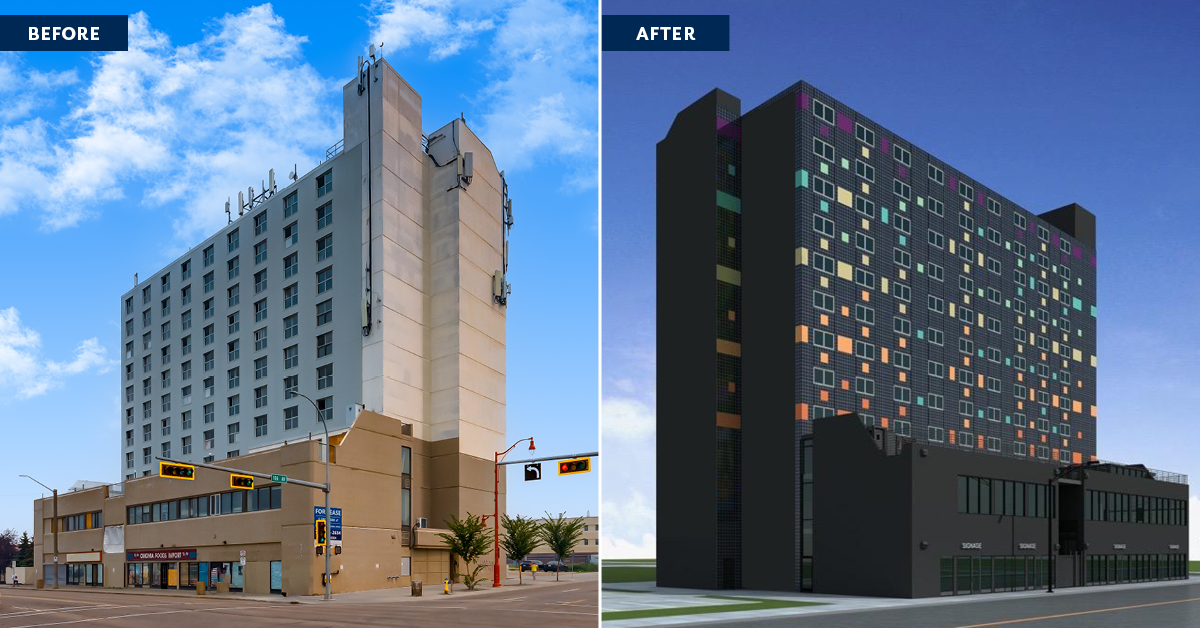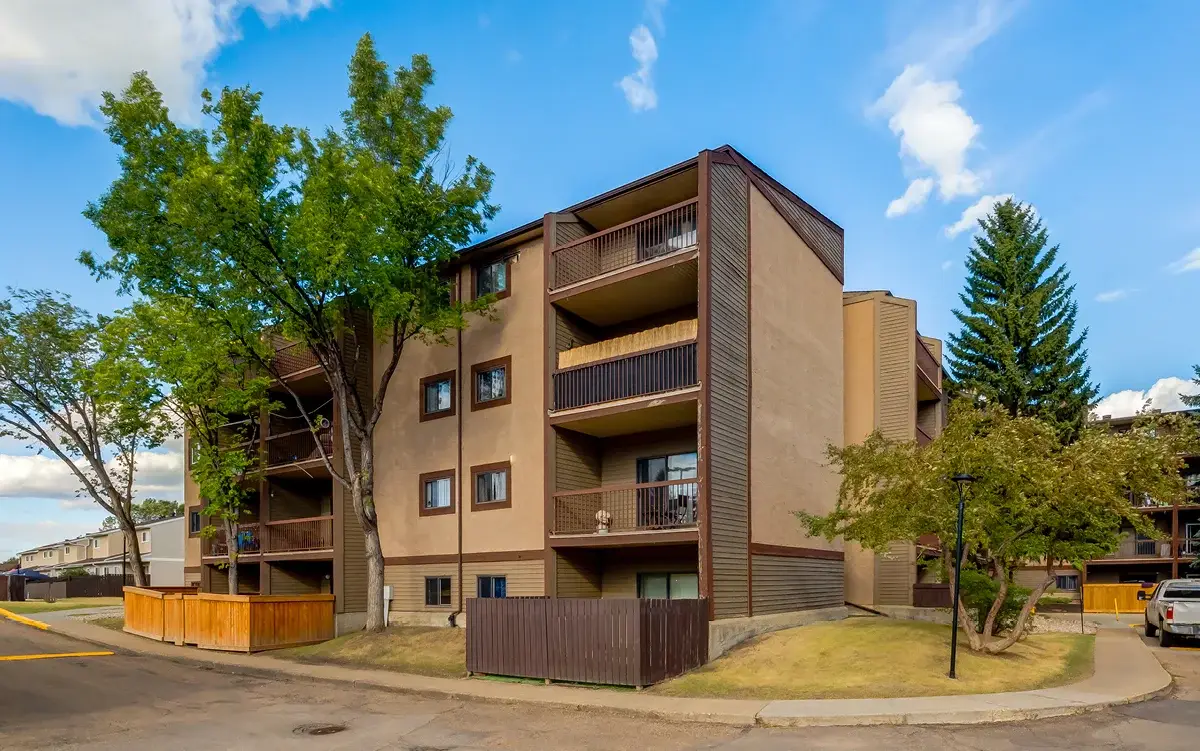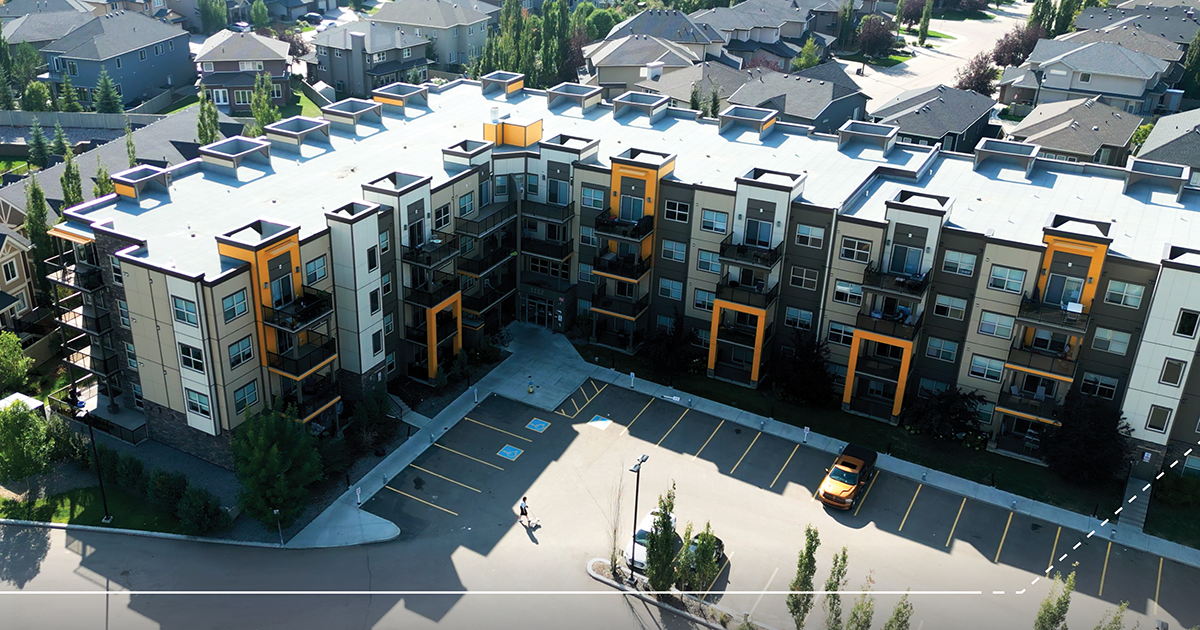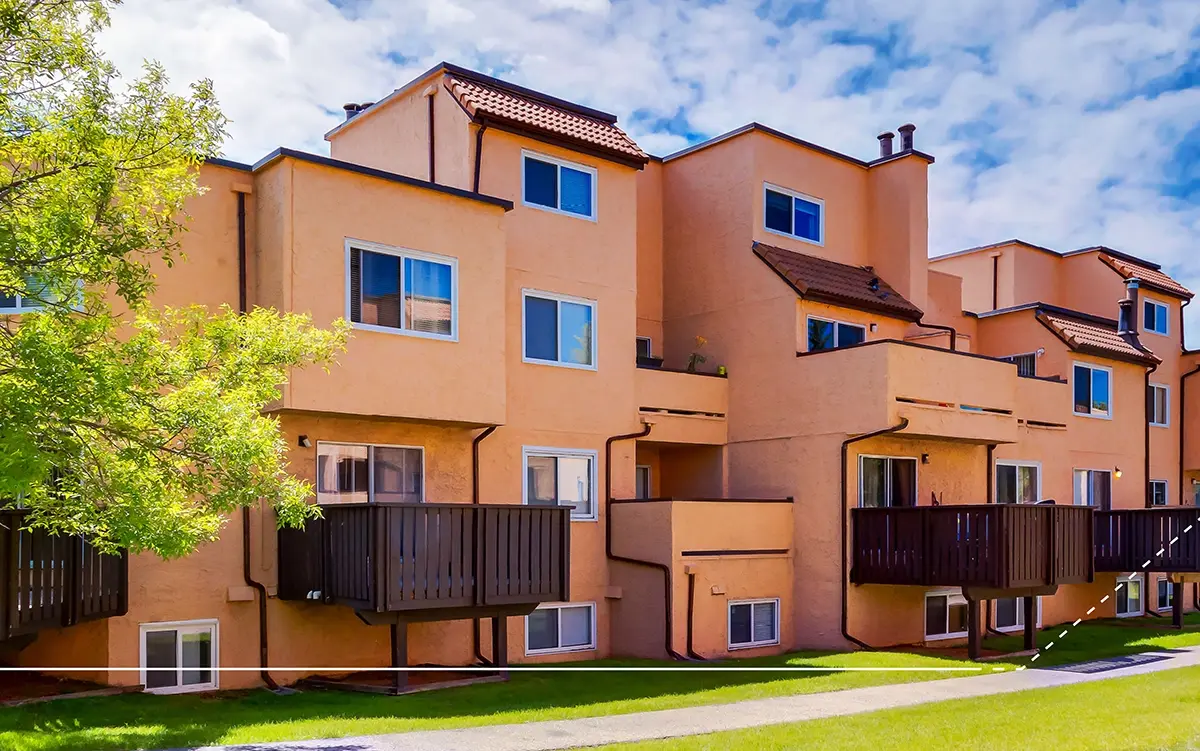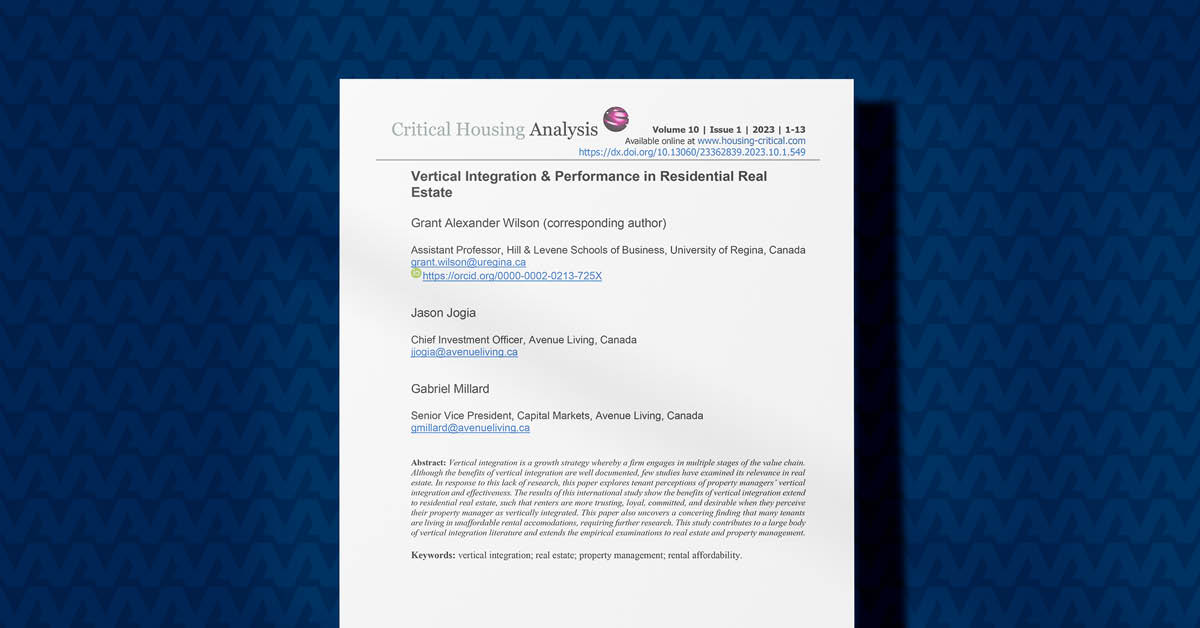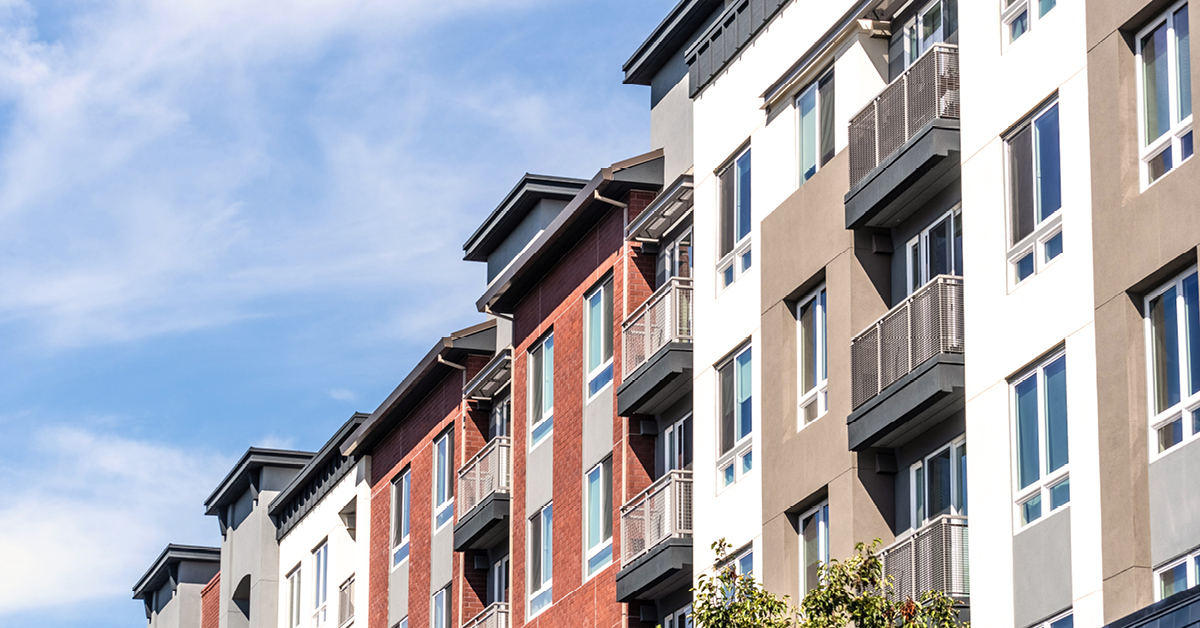Over the last year, we’ve stayed the course and once again proved we’re equipped to navigate any environment.
We saw a number of formative milestones in 2023, including our largest acquisitions to date in both our multi-family and self-storage funds as well as achieving over $5 billion in assets under management.
Moving forward, our focus is on bringing our proprietary management model to more Canadians and expanding our investment offerings.
Investing in Alberta Real Estate | Edmonton
Avenue Living has always believed that the Prairies is a region filled with promise. We were founded here and have strategically invested in Alberta since 2006, and today we own and operate approximately 3,500 multi-family units in Edmonton alone. While others may have looked eastward, or to the coasts, we have kept our eyes firmly on western Canada.
“We’re focused on continuing to build our multi-family residential portfolio in the Prairies,” says Gabe Millard, SVP Capital Markets — Equity & Research. “There’s plenty of opportunity to deliver safe, affordable, comfortable housing to our target demographic, workforce housing residents.” Amid rising interest rates and inflation, Alberta attracts people from other provinces as well as new arrivals to Canada due to its affordable cost of living and strong employment prospects.
Promising Market Demographics
Alberta has experienced population growth in the past year, especially inter-provincial migration — in 2023, it led the country, with a rate significantly higher than other provinces. Edmonton’s population is expected to grow from 1.25 million to 1.86 million by 2033, and the city is expected to surpass the two-million mark by 2041. In 2023 alone, the province grew by 3.5%.

Many industry experts anticipate the demand for multi-family residential rentals to increase as the population ages, a trend that holds true in many municipalities. The demand for apartment-style housing tends to be high among younger populations just forming households, then rises again as people grow older and seek alternatives to single-family homes.
Alberta is known for its affordability, and Edmonton has a reputation as an affordable “big city.” In 2022, a benchmarking study ranked Edmonton among the most affordable in the country.
Industry and Employment
In addition to being an affordable city, Edmonton boasts a high median renter income, 42% higher than the national median thanks to strong employment opportunities. While the province is renowned for its energy sector, an industry that has driven employment for decades, Edmontonians also work in a variety of other industries. The city has a strong technology sector, fueled by its reputation as a leading research and education centre — the University of Alberta is home to the National Institute for Nanotechnology and the Alberta Machine Intelligence Institute. The city is also home to several regional offices of major banks.
Edmonton’s largest employer is Alberta Health Services (AHS); the government of Alberta is second. The University of Alberta is also a top employer, and one of the country’s leading research institutions. In total, there are six post-secondary institutions in the city, which provide services to 180,000 full and part-time students each year. Other leading employers include manufacturers, engineering firms, and retail — the West Edmonton Mall is the largest shopping centre in North America, and the city is also home to the continent’s largest open-air retail development.
Edmonton’s location is also a draw for the distribution and logistics sector, it’s home to a major intermodal freight facility, and CN Rail has announced intentions to consolidate operations in Edmonton.
Culture and Recreation
Edmonton has a thriving cultural scene. Known for its arts festivals (including the Edmonton Fringe), you’ll find 25 local theatre companies, contemporary dance troupes, and more. The city is also filled with museums and art galleries, including the Royal Alberta Museum and the Alberta Art Gallery.
The ICE District — the area surrounding the Rogers Place Arena — is home to restaurants, entertainment, retail, hotels, and office space, all in the downtown core. The revitalized, mixed-use district attracts tourists and Edmontonians alike.
Nearby, the Edmonton River Valley Park attracts visitors on foot or on bike. The park is the largest urban park in North America, and boasts more than 160 km of maintained pathways that connect 20 major parks. People flock to the park year-round to boat or canoe, for picnics, to run, walk, bike, or cross-country ski and skate in the winter months.
South of the valley is Old Strathcona, a historic district home to retail, farmer’s markets, pop-up art galleries, and restaurants. The neighbourhood is a registered provincial historic area, populated with heritage buildings erected in the early part of the 20th century.
On the horizon
Avenue Living is investing in a significant renovation of its Capital Tower building, a 12-storey, 179-unit complex in the city’s downtown core, acting as a gateway to Chinatown. This set of deep retrofits includes an 85-foot art installation by renowned Edmonton artist Lance Cardinal, and this mural will be constructed as a vertical solar array to reduce greenhouse gas emissions. The refurbishment of this building will contribute to the growing community in this district, which is on the upswing.
That sense of community is something we strive to foster in all our properties — and we see plenty of opportunities for growth across the city.
This commentary and the information contained herein are for educational and informational purposes only and do not constitute an offer to sell, or a solicitation of an offer to buy, any securities or related financial instruments. This article may contain forward-looking statements. Readers should refer to information contained on our website at https://avenuelivingam.wpenginepowered.com/forward-looking-statements for additional information regarding forward-looking statements and certain risks associated with them.
Capital Tower: A Beacon of Sustainability and Community Revival in Edmonton
Examining personal financial advisors’ knowledge, client recommendations, and personal investments in private real estate and REITs
Real estate investment trusts (REITs) have gained considerable investment participation and academic research since their rise in the 1990s. However, there was little known about personal financial advisors’ knowledge about REITs.
Together with Grant Wilson, we explored personal financial advisors’ knowledge, perceptions, and practices regarding public REITs, private REITs, and private real estate investments. Our findings will help to inform us on how we can add value for the advisor community and their clients.
Read more from our peer-reviewed research published in the Journal of Financial Services Marketing:
The Benefits of Submetering in Multi-Family Residential
Rising energy costs and the environmental impacts of energy consumption are at the forefront of Canadians’ minds. Statistics Canada reported that Alberta’s electricity prices rose by 128% year-over-year in July. These increased costs, along with the environmental impacts around energy consumption, have prompted organizations and individuals to look for ways to reduce their utility usage.
Traditional methods of charging residents for utilities by including them in fees (based on square footage, for example) might seem straightforward on the surface, but it can end up costing both property owners and residents more.
Residential and commercial buildings in Canada account for 17% of our energy consumption. Reducing that consumption is a key part of the overarching strategy to reduce our greenhouse gas emissions and help meet the Government of Canada’s commitment to achieve net-zero by 2050.
Different Methods of Utilities Distribution
There are three main ways to deliver utilities to a residential unit in a multi-family property.
- Master meters: Traditionally, utilities have been delivered to a master meter, and the total cost of these services is split evenly between the units and included in each resident’s monthly rent. Every resident pays the same price, regardless of how much water or electricity they use each month.
- Individual unit meters: Some properties use individual meters in each suite, and utility hookups and pricing are managed directly by the resident. They assume the costs of access fees and other riders connected to their utility bill and are subject to rate fluctuations. In this case, property owners have no visibility into what the resident is using or how much they pay.
- Submeters: Properties with submeters receive water, gas, and electricity through a master meter, but also have a submeter in each unit to measure individual consumption. Residents pay the submetering company for their utilities, based on how much they use. The property owner might assume the access fees and the resident may have the benefit of a lower rate if the property manager has negotiated one with utility providers.
The Benefits of Submetering
When it comes to energy consumption, knowledge is power. With submeters in each unit, both residents and property owners have a deeper understanding of consumption habits and opportunities to reduce waste.
A clear picture. Individual submetering allows residents to see how much energy they use, and property owners can understand their residents’ usage. With a clear picture of consumption, property owners can make informed decisions about equipment maintenance and upgrades, finding ways to optimize the building’s energy use overall. In turn, residents can see their own consumption patterns, and make decisions accordingly.
Responsibility… and accountability. With submeters, residents are responsible for their own energy, heat, and water use rather than paying a portion of the bill for the entire building. They only pay for what they use, rather than what their neighbours might be consuming. This motivates residents to be mindful of their daily energy usage.
The potential for better rates. Some property owners, like Avenue Living, can negotiate lower bulk utility rates for their residents rather than a single customer could on their own. In addition, property owners might assume some or all of the access fees.
Environmental benefits through reduced emissions. Studies suggest that submeters can reduce a building’s energy consumption significantly — a study in New York revealed that submetering reduced consumption by 18-25%, while a building in Ontario recorded even bigger savings (approximately 40%). This is likely because residents can see their consumption and make choices to reduce it, and property owners can realize the tangible benefits of installing energy-efficient fixtures.
Increased efficiency and building value. The ability to monitor consumption also helps property owners and managers spot equipment failures or building inefficiencies. A spike in water consumption could indicate a leak, for example, or high energy use could flag the need for appliance upgrades. This insight allows the property owner to be proactive about maintenance, increasing the property value and comfort for residents.
Avenue Living’s Submetering Strategy
Avenue Living has transitioned several buildings to a submetered system. The submeters we have installed are certified by Measurement Canada, and the program is implemented through a certified third-party provider.
“Avenue Living still covers the cost of utilities in common areas and vacant units,” notes Daniel Klemky, Energy Manager at Avenue Living. “But with submetering we can now give residents the tools to take control of their own costs and be accountable for them. In many cases, we also give people the benefit of a much lower utility rate, due to our negotiations with the providers as part of our procurement strategy.”
The comprehensive insight we get from submetering will allow us to accurately measure the impact of our energy efficiency capital improvements (e.g., replacing a furnace or installing solar panels). And as we continue to upgrade our properties through the deep energy retrofit program, in partnership with the Canada Infrastructure Bank, submetering will play a crucial role in meeting the reporting and data collection requirements.
Submetering provides numerous benefits to both the resident and the owner and is becoming a common tool for property managers to quickly take control of energy consumption, and reduce emissions and operational costs.
This commentary and the information contained herein are for educational and informational purposes only and do not constitute an offer to sell, or a solicitation of an offer to buy, any securities or related financial instruments. This article may contain forward-looking statements. Readers should refer to information contained on our website at https://avenuelivingam.wpenginepowered.com/forward-looking-statements for additional information regarding forward-looking statements and certain risks associated with them.
Revitalizing Canada’s Housing Landscape: The Crucial Role of Retrofits
As cities across North America deal with a growing crisis in affordable housing, it is clear that the solution is not one-size-fits-all and it involves more than simply building new stock. The Canada Mortgage and Housing Corporation (CMHC) estimates that Canada needs to add an additional 3.5 million units, above the current build pace, by 2030 to restore housing affordability. With rising interest rates and inflated costs, the ability to own a home is becoming out of reach for many. Further, there’s a concern that there are not enough rental properties for the population who need them. Add to that the constraints of building permits, labour shortages, and spiralling costs for developers, it is essential to look at other ways to support individuals and families. One such approach is to retrofit existing housing stock.
While building new homes is essential and necessary, reinvigorating existing housing is equally as important to ensure that people have safe and comfortable homes and to curb greenhouse gas emissions. With approximately 90% of Canada’s existing multi-family housing built before the year 2000, many of these buildings are reaching an age where renovations and upgrades are required to improve overall energy efficiency and quality.
In a recently published CMHC report, it states that in order to achieve housing affordability, there must be a “variety of housing options available” including those for both ownership and rental, a mix of single-family and multi-family homes, and new builds and retrofits. “Partnerships and innovation are needed in all parts of the housing system,” says the report.
Strategic Retrofits Are Key
In 2022, Avenue Living embarked on a landmark partnership with the Canada Infrastructure Bank and other key industry partners to retrofit approximately half of its multi-family portfolio. The initiative demonstrates a solid business case for the property management industry to make widespread changes.
Catalys, an energy and sustainability program designer, and one of the partners we have engaged to help achieve our deep retrofit goals, understands exactly what a difference these improvements can make. The firm has a track record of working with a variety of enterprise clients to help reduce their environmental impact by designing energy and sustainability programs, either through retrofits or improved processes. Catalys employs a data-driven technology and AI analysis model that helps property owners maximize the environmental benefits of retrofits and other investments.
“The environmental impacts of demolishing an existing building and replacing it with a new development can be significant,” says Luke Ferdinands, CEO of Catalys. “Both deconstruction and construction are waste-intensive, and a deep refurbishment of an existing building cuts operational carbon emissions — without the emissions associated with building new. Approximately 60% of embodied carbon emissions are associated with the sub-structure, frame, upper floors, and roof of a building. A deep retrofit will generally retain these elements, meaning on average, the carbon footprint of a refurbished building is about half that of the newly-built replacement.”
The firm has provided consultation and support to Avenue Living throughout the project, from feasibility studies to ongoing program management. As the retrofits scale, Ferdinands and his team will continue to assist with managing complexity, verifying performance, and measuring success through data tracking and analysis.
Benefits of Retrofits, from the Bottom (line) Up
Retrofitting can be completed much more efficiently than new builds, which often require lengthy schedules due to permitting and other considerations. “In Canada, a new building can take well over two years to be completed”, says Ferdinands. “Retrofits can take far less time — and they can benefit from streamlined processes that some municipalities have in place to expedite the permitting for such projects.
“When executed properly, deep retrofits can deliver buildings that appear to be totally different — they look newer and with a more modern aesthetic,” continues Ferdinands. “But more importantly, the resident experience of living there is also significantly improved.”
Studies show that living in an energy-efficient or “green” building improves residents’ overall quality of life. Not only are they living in more comfortable spaces, but they experience better health through upgraded lighting and balanced heating and cooling. In many cases, these buildings can become a vital part of the social fabric of a community — as Canada’s Green Building Council (CGBC) notes, “everyone benefits when community members have access to healthy, affordable housing and when communities are resilient and can withstand extreme weather events.”
Not all retrofits involve turning over the entire building; some upgrades can be quite simple, yet still achieve positive results. Less complex upgrades, such as boiler replacement or rooftop solar PV installations, mean residents can remain in place as retrofits occur with minimal disruption in their daily lives. “From a continuity perspective, it’s really important to make these upgrades as seamless as possible to minimize the impacts to the people who have made that building their home,” says Ferdinands.
These retrofits bring aging stock up to today’s standard, but they also ensure buildings are optimized for the future. “We’re making these buildings much more resilient,” says Ferdinands. “With more extreme weather — hotter summers, colder winters, and wildfire smoke – these upgrades really tighten up the building. We’re redoing roofs, adding insulation, improving windows, all of which help the building perform better in different conditions.”
Social Benefits
Ensuring existing buildings remain comfortable, desirable, and affordable places to live helps preserve communities. The ability to live in established neighbourhoods close to transit routes, schools, employment, and amenities offers a better quality of life for renters and encourages neighbourhoods to remain vibrant. Residents who are happy with their neighbourhood and comfortable in their homes are likely to stay, bringing added economic stability to a community. In addition, retrofitted, affordable rentals support a growing and stable population, and encourage local economic growth as working renters, seniors, and children all participate in their community, supporting nearby businesses and services.
“Renewing these older buildings is vital for communities,” says Gabriel Millard, SVP, Capital Markets – Equity & Research, who notes that many are often demolished and replaced with larger, more expensive rental properties. “In Canada, where we have fewer and fewer options at the less costly end of the rental spectrum, renewal helps extend the lifespan of these buildings so they can keep housing families. We’re making sure that important piece of the rental puzzle stays on the market.”
Retrofits for the Future
As we deal with two major challenges — housing affordability and environmental impact — it’s becoming clear that retrofits to existing buildings are a key part of the solution. Through a strategic and sustainable implementation, property managers can bring buildings up to date without losing occupancy. At the same time, residents can reap the health, social, and financial benefits of having a comfortable, affordable place to live in an established community.
This commentary and the information contained herein are for educational and informational purposes only and do not constitute an offer to sell, or a solicitation of an offer to buy, any securities or related financial instruments. This article may contain forward-looking statements. Readers should refer to information contained on our website at https://avenuelivingam.wpenginepowered.com/forward-looking-statements for additional information regarding forward-looking statements and certain risks associated with them.
Avenue Living passes $5B in Assets Under Management
Our CEO and Founder, Anthony Giuffre, sat down with Real Estate News Exchange (RENX) to discuss Avenue Living’s recent acquisitions, growth strategy, and how our expertise as property managers is helping us navigate the current market.
This commentary and the information contained herein are for educational and informational purposes only and do not constitute an offer to sell, or a solicitation of an offer to buy, any securities or related financial instruments. This article may contain forward-looking statements. Readers should refer to information contained on our website at https://avenuelivingam.wpenginepowered.com/forward-looking-statements for additional information regarding forward-looking statements and certain risks associated with them.
Strategic Scaling: Why Avenue Living is Doubling Down on the Prairies
As we continue our focus on operations, we’re also ramping up our acquisition pipeline in the Prairies and further investing in regions that have shown themselves to be defensible even during market slowdowns.
We’ve recently acquired 266 multi-family units in Edmonton and have offers on approximately 2,500 more. This expansion aligns with a growing demand for rental properties in the region, driven by population growth and limited supply.
This commentary and the information contained herein are for educational and informational purposes only and do not constitute an offer to sell, or a solicitation of an offer to buy, any securities or related financial instruments. This article may contain forward-looking statements. Readers should refer to information contained on our website at https://avenuelivingam.wpenginepowered.com/forward-looking-statements for additional information regarding forward-looking statements and certain risks associated with them.
A Proven Alternative | Communicating Our Value Proposition
Alternative investments are enjoying a rise in popularity, but not all are created equal.
Investments in alts, such as real estate, may offer opportunities to increase diversification and generate competitive returns while potentially providing protection against inflation. Avenue Living’s funds offer an accessible way to invest in multi-family real estate, farmland, and self-storage.
Learn what investors should look for:
This commentary and the information contained herein are for educational and informational purposes only and do not constitute an offer to sell, or a solicitation of an offer to buy, any securities or related financial instruments. This article may contain forward-looking statements. Readers should refer to information contained on our website at https://avenuelivingam.wpenginepowered.com/forward-looking-statements for additional information regarding forward-looking statements and certain risks associated with them.
2023 Mid-Year Review: Laying the Foundation for Stability and Growth
As our leadership team reflects on the first half of 2023, the theme is one of sustainability and continued growth for Avenue Living. As we progress throughout the year, we’re poised to reach new milestones given the strong foundation we have spent the last few years cultivating. Each of our funds has access to a robust vertically integrated platform with talented experts in finance, legal, marketing, technology, accounting, HR, and customer service to support their operations. As we grow, that platform scales with our different businesses, allowing us to maximize efficiency across the organization.
Multi-Family
This year, our Core Trust has sustained its steady growth trajectory, as the groundwork from previous years allowed us to find upside in constrained markets. Our approach as an active property manager, and the platform we have built to support our operations, has helped us deliver superior resident experiences and manage our assets while mitigating rising costs.
“We remain focused on our defensibility and advancing our business for the rest of 2023,” says Avenue Living Founder and CEO, Anthony Giuffre. “We continue to be bullish on the Prairies given its population growth and affordability when compared to other markets.” Our multi-family acquisition pipeline includes over 3,000 units in the region which have the potential to close in the latter half of 2023 or early 2024, which could bring our portfolio to over 18,000 units.
“Our investments in people and technology have created the basis for us to support new acquisitions across our asset base without increasing management costs,” says Jason Jogia, CIO of Avenue Living. “This ability to scale, coupled with our ability to borrow strategically while taking advantage of the inverted yield curve, allows us to minimize our costs while investing in our assets and delivering a superior resident experience.”
Sustainability remains a key cornerstone of our business, as we invest in capital improvements and strategically plan our projects to reduce greenhouse gas emissions across our portfolio. These projects — many of which will launch in the second half of 2023 and progress over the next four years as part of our landmark partnership with the Canada Infrastructure Bank — will improve the energy consumption of approximately 240 buildings and enhance comfort for around 10,000 Avenue Living Communities residents.
Self-Storage
Mini Mall’s focus on operational efficiency at the beginning of 2023 has been key to its growth. This approach has allowed the front-line customer service team to deliver a consistent experience at every location, bringing new acquisitions to the MMSP standard.
“With over 100 stores coming online last year, we wanted to stabilize our operations and quickly produce consistent performance and results on these assets,” says MMSP CEO, Adam Villard. Mini Mall delivered on that by adding operational expertise to the executive team and focusing on efficiency, resulting in close rates increasing by 48% and delinquencies decreasing by 84% between January to June.
“We’ve really been focused on ‘the three C’s’,” says Villard, “closing, cleaning, and collecting.” By putting strategic practices in place to help close leads, bringing facilities up to the Mini Mall standard for aesthetics and cleanliness, and lowering delinquencies, site managers and staff can concentrate on creating a seamless customer experience across the organization.
Mini Mall also implemented new marketing and customer service strategies to refine its lead generation process, which doubled results between the end of March to the end of June. “Those efforts are really what’s driving our business right now,” says Villard.
Going forward, Villard sees Mini Mall maintaining strong occupancy throughout the winter to balance the seasonal fluctuations the industry is known for, and continuing to drive targeted programs to build on revenue and occupancy numbers.
Farmland
2023 has been a notable year for our farmland investments as we developed and launched Tract Farmland Partners – building on the success of our Avenue Living Agricultural Land Trust. Interest in farmland as an investment gained traction during the pandemic and it shows no signs of slowing. In its first six months, Tract now holds 3,560 acres of arable land.
CEO of Tract Farmland Partners and Agricultural Land Trust, Leif Snethun, credits the recent world events for the uptick in people’s interest in food supply, noting that the launch of the Agricultural Land Trust in 2017 was slower to get underway than Tract has been. There has always been interest in farmland, but since 2020 it has become more widespread among investors.
“The farmland industry has always been a wonderful space to be in,” says Snethun. He sees Tract adding more assets to its portfolio for the remainder of 2023. “I’m eager to see the momentum build as people remain interested in the agricultural sector and want to know where their food comes from.”
Our Path Forward
The first half of 2023 has been significant for our investment vehicles, as we fostered our ground-breaking partnerships, launched new projects, and saw growing investor interest in our asset classes. Our active management model and platform of services — coupled with careful planning and analysis — will allow us to capitalize on a breadth of opportunities. We’re excited to continue driving our business forward and deliver a competitive advantage in these unique economic times.
This commentary and the information contained herein are for educational and informational purposes only and do not constitute an offer to sell, or a solicitation of an offer to buy, any securities or related financial instruments. This article may contain forward-looking statements. Readers should refer to information contained on our website at https://avenuelivingam.wpenginepowered.com/forward-looking-statements for additional information regarding forward-looking statements and certain risks associated with them.
What is Workforce Housing?
Workforce housing residents comprise a substantial part of an economy’s essential services, with studies suggesting they represent 40% of the renter population. Avenue Living’s strategic focus on multi-family residential, and specifically the workforce housing demographic, anticipates the growth of this important segment of the population and their increasing demand for high-quality, affordable housing.
Starting in the 1970s as an experiment in American ski towns, workforce housing provides affordable and conveniently-located housing options for individuals and families who are part of the local workforce. These homes, like those first developed in Colorado as described in the video, are available for people who work in the region but may have difficulty affording market-rate housing due to lower incomes and consistently increasing housing costs.
Over the decades, workforce housing has expanded well beyond purpose-built communities across North America. Similar developments and buildings can be found in various communities, and they continue to meet the needs of workers who earn moderate to middle-income wages (approximately $15-$50 in Canada).
As a crucial part of a well-functioning community, workforce housing offers many benefits for residents and the communities they live in. It supports local economies, job creation, and employee development. It reduces commute times and contributes to housing affordability. In addition, a community rich with workforce housing can see benefits such as increased access to healthcare and education, while promoting diversity and inclusion, and a higher quality of life.
Watch the video to learn more about the history of workforce housing and why it’s the focus of our multi-family investment funds.
This commentary and the information contained herein are for educational and informational purposes only and do not constitute an offer to sell, or a solicitation of an offer to buy, any securities or related financial instruments. This article may contain forward-looking statements. Readers should refer to information contained on our website at https://avenuelivingam.wpenginepowered.com/forward-looking-statements for additional information regarding forward-looking statements and certain risks associated with them.
REimagining Real Estate with Anthony Giuffre
What Investors Need to Know About Borrowing Amid Rising Interest Rates
The past year has been punctuated with announcements of rising interest rates, as the Bank of Canada (BOC) redoubled their efforts to combat inflation with successive rate hikes. The latest, in July, brought the overnight rate up by 25 basis points to 5%, its highest since early 2001. Changes in interest-rate policy can have wide-ranging effects throughout the economy, and for real estate investors, it’s vital to interpret the different outcomes between long-term and short-term rates. Understanding the inversion of the yield curve — where long-term interest rates are lower than short-term rates — can help well-prepared property owners mitigate risk.
Understanding the Yield Curve

Figure 1
During the period of rising interest rates, there has been a notable difference between prime-based borrowing rates and bond-based borrowing rates in Canada. While the prime rate has experienced significant increases (from 2.7% in March of 2022 to 6.95% in June of 2023), the Canadian 10-year bond rate has remained relatively stable over the same period. Whereas retail borrowing is often based on prime, commercial borrowing is traditionally based on long-term government bonds. Therefore, well-managed commercial borrowers will generally be less impacted — as compared to retail borrowers — by the recent rise in interest rates. One of the many upsides to indirect real estate investment through entities such as REITs is that investors are able to benefit from the relationships and knowledge of a team of experts. By indirectly investing in real estate, everyday investors can take advantage of bond-based borrowing rates through a strategic asset manager, without becoming a commercial borrower themselves.
With the Canada Mortgage and Housing Corporation (CMHC) setting lending rates at a spread over the 10-year bond, those who have access to bond-based borrowing for long-term decisions have been in a more favourable position since the beginning of 2022. A visual representation of these trends can be observed in Figure 1.

Figure 2
As per Figure 2, during an inverted yield curve, where long-term interest rates are lower than short-term rates, long-term borrowing becomes cheaper than short-term borrowing. By securing financing at lower rates, long-term borrowers benefit from stability and predictability in their interest costs over an extended period. Conversely, short-term borrowers and those with variable rates may experience heightened volatility and financial strain as their borrowing costs increase in response to rising short-term interest rates. The inversion of the yield curve emphasizes how important it is for borrowers to consider duration and structure when interest rates are rising.
Rental property owners facing rising interest rates can take advantage of the differences in duration between short-term leases and long-term debt. Using long-term debt instruments, such as a 10-year mortgage, alongside shorter lease terms, allows property owners to adjust to changing market conditions in real-time, counterbalancing the impact of higher borrowing costs. However, property owners should also consider market conditions and the resident experience before implementing this strategy.
Interest Rates and Homeownership
Rising interest rates — and the resulting increased cost of short-term borrowing — can have a negative impact on development projects, lowering construction activity and limiting the supply of housing units. With fewer developments, the cost of housing increases, leading to higher rents and housing prices. Scarcity of supply and increased borrowing costs compel developers to set higher prices for their projects, ultimately affecting affordability.
A survey conducted by Chartered Professional Accountants Canada identified several barriers to homeownership among non-homeowners in the country. Rising interest rates were cited as the top obstacle by 89% of respondents, followed closely by the affordability of down payments (84%), necessary renovations (83%), and finding a home in a desired area (83%). Other challenges included taxes and mortgage payments (81% each) and income instability (69%).
Existing homeowners also faced hurdles, with renovation costs affecting three out of five individuals, ongoing difficulties in affording home maintenance (46%), and challenges with mortgage payments, property taxes, and utility payments for varying percentages of respondents. These findings shed light on the financial obstacles Canadians encounter in their quest for homeownership, as well as the ongoing strains faced by prospective and existing homeowners.
Navigating the Landscape
Canada’s rising interest rates present distinct challenges for many sectors of the economy — but they also give rise to opportunities. It’s essential for borrowers to understand the benefits and drawbacks of short- and long-term interest rates and formulate their debt strategy accordingly. For property owners, understanding the interest-rate landscape, managing duration, and responding to local market conditions can help minimize borrowing costs and optimize revenue.
Understanding how an asset manager uses different debt vehicles to mitigate risk and reduce borrowing costs allows investors to make informed decisions. Asset managers like Avenue Living, for example, can make strategic use of short- and long-term borrowing to potentially maximize returns and de-risk their portfolios. Considering an asset manager’s borrowing strategy — along with other factors — can help investors find the vehicle that’s right for them.
This commentary and the information contained herein are for educational and informational purposes only and do not constitute an offer to sell, or a solicitation of an offer to buy, any securities or related financial instruments. This article may contain forward-looking statements. Readers should refer to information contained on our website at https://avenuelivingam.wpenginepowered.com/forward-looking-statements for additional information regarding forward-looking statements and certain risks associated with them.
How a Resident-Centred Approach Has Differentiated Avenue Living
A resident-centred approach is foundational to our property management philosophy and a key differentiator of our business model. Putting our residents’ needs at the heart of our acquisition, expansion, and service strategy has been key to our ongoing success.
Read more about how embracing vertical integration has allowed us to create a sophisticated, innovative property management platform.
Multi-Family Retrofits: The Case for Going Green
In June 2022, Avenue Living and the Canada Infrastructure Bank (CIB) joined forces to commit $162 million towards deep retrofits across our Canadian portfolio. The partnership will fund upgrades to 220 residential buildings, touching approximately 6,700 homes and helping lower the carbon emissions for nearly half of our Canadian portfolio.
As a key pillar of our ESG efforts and overall strategy, Avenue Living has always made responsible and impactful capital improvements — for example, installing a better-insulated roof, higher-efficiency windows, or a new boiler. These energy conservation measures (ECMs) extend the life of the asset and make living spaces more comfortable in summer and winter.
Our portfolio spans a region with some of the coldest weather in North America, and these upgrades help increase energy efficiency. A better-insulated building envelope, for example, keeps the building temperature more even year-round and allows heating and cooling systems to work more effectively. Upgraded high-efficiency HVAC systems, paired with better-insulated building envelopes, help reduce consumption.
In 2020, commercial and residential buildings accounted for 17 per cent of Canada’s GHG emissions (excluding construction and building materials, which pushes the number to 30 per cent). The Government of Canada is committed to reducing carbon emissions to below 45% of 2005 levels by 2030 and reaching net-zero by 2050 — and estimates that, to meet that goal, Canada needs to retrofit 600,000 homes and 750 million square feet of commercial space per year between now and 2040 to meet those commitments.
Avenue Living is doing our part while paving the way to setting a new standard in the multi-family industry. As an open-source advisor and collaborator, we are sharing how these retrofits can benefit investors, residents, and our communities at large. Our partnership with the CIB aims to reduce emissions from buildings in the program by 50 per cent, and pilot projects are already underway.
CHOOSING ENERGY CONSERVATION MEASURES (ECMS)
Retrofitting buildings to create the most energy savings is based on careful analysis, energy audits, and a well-developed strategy for capital improvements. As part of our current acquisition strategy, Avenue Living systematically determines which capital improvements will be the most impactful for each property. Deep energy retrofits are no different.
Before a property can be included in the CIB retrofit program, it must meet Investor Ready Energy Efficiency (IREE) Certification. IREE is a global framework that signals a building has undergone appropriate due diligence and the retrofit projects have been developed by qualified professionals who adhere to a series of protocols for assessing risk, comparing savings, and evaluating opportunities. This third-party certification reduces costs for transactions, capital, and due diligence and increases investor confidence through reliable and consistent projections.
Baselining is essential to determining the viability of any retrofit project, and as part of IREE protocols, our buildings have undergone multiple energy audits. When we examined our portfolio in search of the most impactful ECMs, we discovered our larger properties — those with more than 24 units — presented our best opportunity to reduce GHG emissions. Energy audits have also revealed that wood-frame buildings can be further optimized compared to brick or concrete buildings, which are already quite efficient. In addition, we closely evaluated other aspects of the building’s mechanical operations and construction for ways to increase efficiency — roofs, boilers, and exterior cladding, for example.
“As we were going through the program details, we looked at a number of factors to determine if a building would be a good candidate for upgrades, for example, will the improvements offset enough energy and emissions to be financially viable, or is the building equipment old or inefficient,” says Daniel Klemky, energy manager at Avenue Living. “If building equipment is reaching the end of its useful life, there may be an opportunity for us to modernize that property in a cost-effective way.”
Our retrofits include:
- Upgraded heating, ventilation and cooling (HVAC) systems, which allow us to heat and cool buildings more efficiently and keep temperatures even throughout the property
- An upgraded building envelope and roof, which improves insulation, eliminates the possibility of pipes freezing and improves aesthetics
- Triple-glazed, high-efficiency windows, to reduce heat loss (or gain)
- Low-flow water fixtures, to reduce water consumption and provide a better experience for residents
- LED lighting and more efficient fixtures, for brighter, more effective lighting in common areas
- Solar panels, where applicable, allow properties to generate their own power, reduce consumption, and offset operational costs
Implementing these retrofits requires coordination — and manpower. Our plan has incorporated a phased approach, which allows us to make as many updates as possible without overwhelming the trades in each city. This perfectly illustrates the combined benefit of environmental projects: job creation, and the need for expansion in the sector. Canada’s Green Building Council estimates that by 2030 the opportunities for growth in the green building sector could account for approximately 1.5 million jobs and contribute $150 billion in GDP.
“It is difficult to retrofit multiple buildings in a single market at one time,” says Ward Woolgar, senior vice president, capital investment at Avenue Living. “We’ve planned out our retrofits with projected schedules and dates to make sure we have the tradespeople we need available at each phase to minimize delays.”
The solar project slated for Wetaskiwin Mall, for example, requires extensive work on the roof. “It’s not as simple as just putting solar panels on top of the existing structure,” says Klemky. “There’s a great deal of work that has to happen to the roof first, such as detailed design, structural reinforcement, electrical capacity considerations, and regulatory restrictions.” The mall’s solar retrofit, however, will also account for the biggest reduction in emissions.
BENEFITS BEYOND EMISSIONS REDUCTION
While reducing consumption and emissions is our primary goal, we know that these building improvements have other benefits for residents. As an active property manager, we recognize that happy residents stay in their homes for longer, and these upgrades will enhance the comfort and livability of their rentals. Studies show North Americans spend approximately 90 per cent of their time indoors, so air quality, temperature, and lighting are more important than ever.
These renovations require minimal disruption to residents’ lives or schedules, and in most cases happen outside the suites. Although retrofits like window replacement or upgrading water fixtures do require apartment entry, these jobs can be completed in just a few hours, like any regular maintenance task. That said, any construction work in a building has an impact on its occupants, and we’ve developed a plan to communicate with our residents early and often to ensure they understand the work schedule.
“These updates will have a noticeable effect,” says Woolgar. “For example, our upgrades to HVAC systems will mean there’s more even heating throughout the building, so we’ll avoid the problem with overheated hallways and common areas that a lot of apartment buildings have. New windows and fixtures will also mean residents can enjoy more even temperatures in their suites, better water flow and lighting, and improved aesthetics.”
A GREENER FUTURE FOR MULTI-FAMILY
The United Nations estimates that 80% of the buildings in cities today will exist in 2050. Reducing emissions through deep-energy retrofits is key to ensuring Canada — and the world — meets sustainability targets. For Avenue Living, the benefits of this retrofit project are very close to home: we see these retrofits as an opportunity to demonstrate to the industry what is possible. We aim to create a portfolio of properties that provide residents with safe, affordable, comfortable, and modern homes — ones that are well-equipped for a low-carbon future.
This commentary and the information contained herein are for educational and informational purposes only and do not constitute an offer to sell, or a solicitation of an offer to buy, any securities or related financial instruments. This article may contain forward-looking statements. Readers should refer to information contained on our website at https://avenuelivingam.wpenginepowered.com/forward-looking-statements for additional information regarding forward-looking statements and certain risks associated with them.
Vertical Integration and Performance in Residential Real Estate
Renters Have Stepped Up Efforts to Address the Housing Crisis — It’s Time for Property Managers to Do the Same
At the heart of our business model lies a strong commitment to serving our customers. We’re keenly aware of market changes and take proactive steps to ensure we’re meeting the wants and needs of the workforce housing demographic. Our approach sets us apart from other asset managers in the industry and has allowed us to build lasting relationships with our residents.
An International Examination of Market Orientation and Performance in Residential Property Management
This Year’s Most-Read: Our Top Content in 2022
We’ve gathered the blog posts, articles, and white papers that garnered the most interest from our readers last year. They cover a diverse range of topics, from our partnership with the Canada Infrastructure Bank to the complexities of the private rental housing market, but they all come back to one thing: understanding the real estate investment landscape. As investors seek opportunity in a changing market, it’s important to explore and analyze the fundamentals that impact our industry to refine our strategy and provide value for our residents, our investors, and the communities in which we operate.
PRESS RELEASE:
This announcement is the next step in our commitment to ESG — one we officially started when we began a relationship with PRI (Principles for Responsible Investing). Our partnership with Canada Infrastructure Bank will allow us to undertake capital improvements that reduce our carbon footprint and provide comfortable homes for our residents, without compromising affordability.
WHITE PAPER:
RE-EXAMINING A HEDGE AGAINST INFLATION: Multi-family Residential Real Estate
This paper examines the effects inflation and rising interest rates have on affordability, and how investors may find opportunities in multi-family real estate.
PEER-REVIEWED WHITE PAPER:
PRIVATE RENTAL TARGET MARKETS: A COMPREHENSIVE SPECTRUM
Our founder and CEO, Anthony Giuffre, collaborated with the University of Regina’s Dr. Grant Wilson on this examination of the North American rental housing market, identifying the lifestyles, demographics, and value propositions that make up six major groups in the housing spectrum. The peer-reviewed paper was published in the International Real Estate Review in April 2022.
WHITE PAPER:
DIVERSIFICATION WITH AND WITHIN REAL ESTATE
This white paper explores how diversification in real estate portfolios — across asset types and markets — can enhance value for investors, helping them minimize risk and maximize the potential for returns.
BLOG:
WHY WE SEE OPPORTUNITY IN THE WORKFORCE HOUSING MARKET
We examined factors that make the workforce housing market an attractive investment opportunity and why it’s the focus of our multi-family strategy.
This commentary and the information contained herein are for educational and informational purposes only and do not constitute an offer to sell, or a solicitation of an offer to buy, any securities or related financial instruments. This article may contain forward-looking statements. Readers should refer to information contained on our website at https://avenuelivingam.wpenginepowered.com/forward-looking-statements for additional information regarding forward-looking statements and certain risks associated with them.


